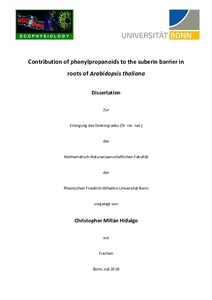Contribution of phenylpropanoids to the suberin barrier in roots of Arabidopsis thaliana

Contribution of phenylpropanoids to the suberin barrier in roots of Arabidopsis thaliana

| dc.contributor.advisor | Franke, Rochus Benni | |
| dc.contributor.author | Millán Hidalgo, Christopher | |
| dc.date.accessioned | 2020-04-26T09:57:57Z | |
| dc.date.available | 2020-04-26T09:57:57Z | |
| dc.date.issued | 05.02.2019 | |
| dc.identifier.uri | https://hdl.handle.net/20.500.11811/7859 | |
| dc.description.abstract | The apoplastic polyester suberin forms a barrier in root endodermal and peridermal tissue. Transmission electron microscopy (TEM) displays the lamella-like structure of suberin which is divided into light (electron-translucent) and dark (electron-dense) bands. The regularity of this ultrastructure has led to the proposed models that the electron-translucent bands consist of the aliphatic moieties whereas the electron-dense bands represent the aromatic compounds. An additional apoplastic barrier in the endodermis is represented by Casparian strips (CS) which are dominated by the aromatic polymer lignin. In the past, suberin research was mainly focused on the aliphatic compounds whereas little is known about the contribution of aromatic constituents to suberin structure and function. Therefore, an array of mutants and transgenics was screened in pathways for modifications in suberin content, composition and distribution to elucidate the role of the aromatics. The development of the endodermal apoplastic barrier was analysed in seedlings by staining specifically the suberin and the Casparian strip barrier. Recent studies showed that a defective Casparian strip barrier is often accompanied by ectopic suberisation. In contrast, in this study mutants were isolated and further investigated with defective Casparian strip barrier and decreased suberisation and functional Casparian strip but increased suberisation. Moreover, mutant lines lacking in esterified aromatic compounds were isolated and the ultrastructure of the suberin polyester was analysed by TEM. Despite of the loss of esterified aromatic compounds a lamellar-like structure is still present, but a local wavy suberin band is observable. Possibly, suberin is anchored via aromatic compounds in the cell wall. Finally, the different phenylpropanoid pathway mutants enable the study of the contribution of both endodermal barriers to root physiology like water as well as nutrient transport and ion homeostasis within the plant body. | en |
| dc.language.iso | eng | |
| dc.rights | In Copyright | |
| dc.rights.uri | http://rightsstatements.org/vocab/InC/1.0/ | |
| dc.subject | Suberin | |
| dc.subject | Ferulasäure | |
| dc.subject | Caspary-Streifen | |
| dc.subject | Diferulasäure | |
| dc.subject | Ultrastruktur | |
| dc.subject | ferulic acid | |
| dc.subject | Casparian strips | |
| dc.subject | diferulic acid | |
| dc.subject | ultrastructure | |
| dc.subject.ddc | 580 Pflanzen (Botanik) | |
| dc.title | Contribution of phenylpropanoids to the suberin barrier in roots of Arabidopsis thaliana | |
| dc.type | Dissertation oder Habilitation | |
| dc.publisher.name | Universitäts- und Landesbibliothek Bonn | |
| dc.publisher.location | Bonn | |
| dc.rights.accessRights | openAccess | |
| dc.identifier.urn | https://nbn-resolving.org/urn:nbn:de:hbz:5n-53409 | |
| ulbbn.pubtype | Erstveröffentlichung | |
| ulbbnediss.affiliation.name | Rheinische Friedrich-Wilhelms-Universität Bonn | |
| ulbbnediss.affiliation.location | Bonn | |
| ulbbnediss.thesis.level | Dissertation | |
| ulbbnediss.dissID | 5340 | |
| ulbbnediss.date.accepted | 16.10.2018 | |
| ulbbnediss.institute | Mathematisch-Naturwissenschaftliche Fakultät : Fachgruppe Biologie / Institut für Zelluläre und Molekulare Botanik (IZMB) | |
| ulbbnediss.fakultaet | Mathematisch-Naturwissenschaftliche Fakultät | |
| dc.contributor.coReferee | Dörmann, Peter |
Dateien zu dieser Ressource
Das Dokument erscheint in:
-
E-Dissertationen (4442)




